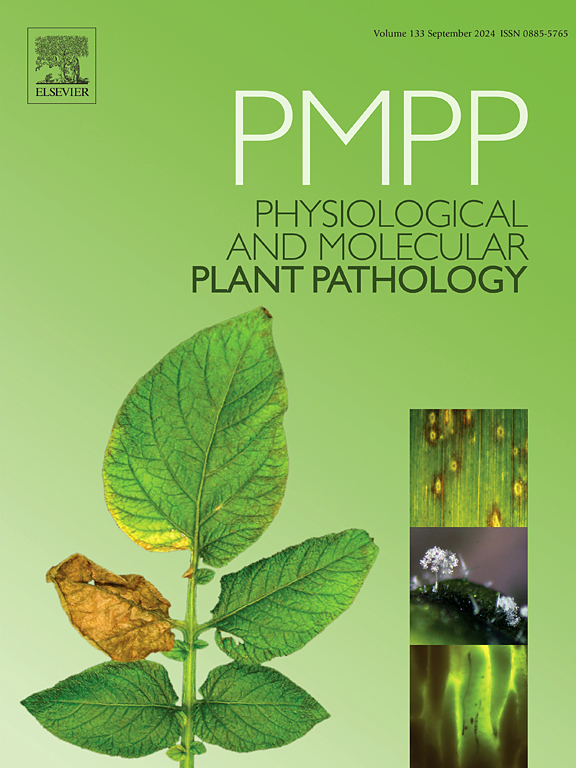果前施用外源atling可防治刺梨病引起的果斑病,提高果实品质
IF 3.3
3区 农林科学
Q2 PLANT SCIENCES
引用次数: 0
摘要
果斑病是贵州省刺梨主产区新近发现的一种真菌病害,严重影响了刺梨的产量和品质。根据致病性、形态学和多基因系统发育分析,确定该疾病的病原为麻氏疏螺旋体(Diaporthe cercidis) lx13菌株,这是首次报道该病原体感染roxburghii。在PDA培养基上,以葡萄糖、蛋白胨和酵母提取物为营养来源,确定了D. cercidis LX13的最佳生长条件为28°C, pH 7.0,全光。体外菌丝生长抑制实验表明,4种植物免疫诱导剂atailin (ATL)、VDAL、Pulvtong和ProAct对cercidis LX13的直接抑菌活性有限(50%)。其中,ATL(有效成分:3%氨基寡糖和3% PeaT1蛋白)的抑菌效果最强(20.05% ~ 49.02%),显著优于其他诱导剂(2.58% ~ 18.96%)。田间试验证明了ATL对刺梨果斑病的防治效果。其诱导抗性在第3次喷施后第14 d达到高峰(防效91.54%),第35 d逐渐下降至最低(防效68.30%)。此外,ATL通过提高抗病化合物(可溶性糖、蛋白质、木质素、类黄酮和总酚)和增强成熟时的抗氧化活性来提高水果品质。本研究首次证明了D. cercidis LX13是刺梨果斑病的致病因子,并强调了ATL是一种生态友好型植物免疫诱导剂,可用于病害的可持续管理,为栽培提供了理论见解和实践解决方案。本文章由计算机程序翻译,如有差异,请以英文原文为准。

Pre-fruit exogenous ATaiLing application controls fruit spot in Rosa roxburghii caused by Diaporthe cercidis and improves fruit quality
Fruit spot, a newly identified fungal disease, has emerged in the major production areas of Rosa roxburghii in Guizhou Province, significantly reducing both fruit yield and quality. Based on pathogenicity, morphology, and multigene phylogenetic analysis, the causative agent of this disease was identified as Diaporthe cercidis strain LX13—the first report of this pathogen infecting R. roxburghii. Optimal growth conditions for D. cercidis LX13 on PDA medium were determined to be 28 °C, pH 7.0, full light, with glucose, peptone and yeast extract identified as favorable nutrient sources. In vitro mycelial growth inhibition assays revealed that four plant immunity inducers, ATaiLing (ATL), VDAL, Pulvtong and ProAct, exhibited limited direct antimicrobial activity (<50 %) against D. cercidis LX13. Among them, ATL (active ingredients: 3 % amino-oligosaccharides and 3 % PeaT1 protein) showed the strongest antifungal effect (20.05 %–49.02 %), significantly outperforming the other inducers (2.58 %–18.96 %). Field trials demonstrated ATL efficacy in controlling fruit spot in R. roxburghii. Its induced resistance peaked at 14 days after the third spray (91.54 % control efficacy), then gradually declined to its lowest level at 35 days (68.30 % control efficacy). Additionally, ATL enhanced fruit quality by elevating disease-resistance compounds (soluble sugars, proteins, lignin, flavonoids, and total phenols) and boosting antioxidant activity at maturity. This study provides the first evidence of D. cercidis LX13 as the causal agent of R. roxburghii fruit spot disease and highlights ATL as an eco-friendly plant immunity inducer for sustainable disease management, offering both theoretical insights and practical solutions for cultivation.
求助全文
通过发布文献求助,成功后即可免费获取论文全文。
去求助
来源期刊
CiteScore
4.30
自引率
7.40%
发文量
130
审稿时长
38 days
期刊介绍:
Physiological and Molecular Plant Pathology provides an International forum for original research papers, reviews, and commentaries on all aspects of the molecular biology, biochemistry, physiology, histology and cytology, genetics and evolution of plant-microbe interactions.
Papers on all kinds of infective pathogen, including viruses, prokaryotes, fungi, and nematodes, as well as mutualistic organisms such as Rhizobium and mycorrhyzal fungi, are acceptable as long as they have a bearing on the interaction between pathogen and plant.

 求助内容:
求助内容: 应助结果提醒方式:
应助结果提醒方式:


